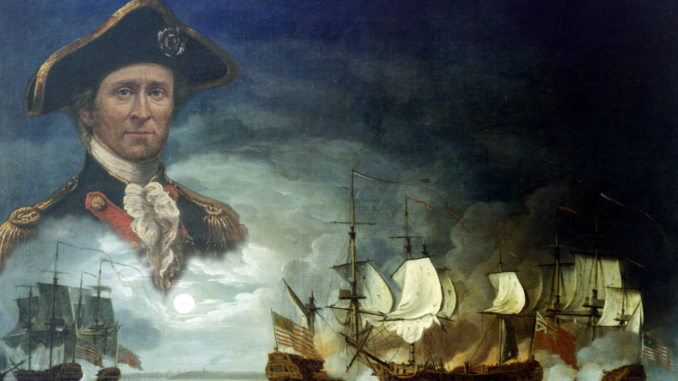
John Paul was born in Scotland in 1747, and put to sea at age thirteen as an apprentice to a ship master. By his mid-twenties, he had become a ship master himself. His career nearly ended prematurely when in 1773 on the Caribbean island of Tobago, a group of sailors demanding advance pay turned on him. In self-defense, Paul killed one of the attackers. Doubting he would be treated fairly in the local court, he found his way off the island and made it to the American colonies, where he adopted the surname Jones to conceal himself.
John Paul Jones, being a Scot and decidedly familiar with the history of how badly the English had treated his countrymen, quickly joined the American rebellion then fomenting against the British.
Thanks to his extensive seafaring experience, Jones was commissioned as a First Lieutenant in December, 1775. The Continental Navy soon gave him command of a sloop, the Providence, in 1776. His expertise as master and commander soon became apparent: he captured sixteen British ships in a single sortie. Jones was promoted to Captain and given command of first the Alfred, with which he claimed still more victories, and then the Ranger.
The Ranger set sail in 1778 with somewhat vague orders to attack the British wherever and whenever possible. Jones was a maverick, and an imaginative and daring one at that. He sailed the Ranger into British territorial waters, indeed to the very shores of England, with an outrageous plan to attack the harbor town of Whitehaven.
Whitehaven had been his home port as a young apprentice, so Jones was very familiar with it. The plan was to burn as many vessels laying at anchor in the harbor as possible at low tide. The harbor was defended by a fort, armed with cannons, or possibly two forts. This is where the storytelling becomes challenging, as the historical records are not at all in agreement, as we will see.
On the clear but cold night of April 22-23, 1778, Jones sailed the Ranger to within a few miles of Whitehaven, where he and about thirty men departed for shore in two small boats, rowing against the tide as it was going out. Because the outgoing current was against them, it took hours longer to reach shore than planned. Daybreak on the morning of the 23rd was not far off.
In the case of there being just one defending fort, Jones and the men in his boat were to take the fort and spike (disable) the cannons, while the men in the second boat were to set fire to the ships at anchor. Jones and his men scaled the walls of the fort and found the garrison either all asleep (in one version of events) or the guards had gone inside for warmth (in another version). Either way, Jones did catch them by surprise, took the fort without bloodshed, and disabled the defending cannons. Meanwhile the men in the second boat failed to set any ships on fire. In one version, the flame in the lantern they had brought with them had gone out, so they went to a nearby pub to relight it but ended up drinking too much. This variation of events is highly suspect and probably the invention of a British newspaper or historian. Furthermore, having failed to set fire to any ships in port, Jones ordered fire set to the fort which spread out of control to the town, burning it to the ground – this version is definitely false.
In the case of two defending forts, the second boat was supposed to take the second fort at the same time that Jones was taking the first fort. However, the men “heard a noise” and were frightened away. Again, this version of events does not have a ring of truth to it, but rather sounds like a story invented to make the American attackers look weak and cowardly.
What does appear to be true is, Jones’ raiding party took the solitary fort without harming the defenders, spiked the cannons, set fire to one ship loaded with coal and made their escape. The town’s fire brigade was able to extinguish the flames before the coal ignited, thus avoiding a calamity. Still, the raid had repercussions far greater than the minor physical damage inflicted.
The British had strong reasons to try to make the Americans look weak and cowardly. Great Britian, a mighty nation which had not been invaded in 700 years, had now been invaded by colonists, Yankee Doodle Dandies, backward bumpkins from the frontiers of the British Empire!
The English populace was in an uproar. The Atlantic Ocean apparently wasn’t enough to keep the war in the American colonies from touching the home island. This was especially upsetting since the war had not been going well for the British since Burgoyne’s surrender at Saratoga the previous year. (That was the first time a British army had ever surrendered. Ever.)
Militias were formed to guard the shores against invasion by American forces. Shipping insurance costs skyrocketed, as as it was perceived that British ships were no longer safe in British waters or even British harbors. Citizens no longer felt safe, secure, or immune to war. Jones’ raid was a psychological victory.
John Paul Jones went on to greater heroics and fame. In September, 1779, during the battle between the American frigate Bonhomme Richard and the British warship HMS Serapis, Jones uttered the words he is most famous for; “I have not yet begun to fight!”
Still, his famous victory over the Serapis did not have as much impact on the war as that time when Jones invaded England.
Question of the night: Have you ever been to England? France? Spain? (Well, where have you been?)
